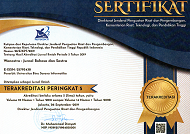Sequential Organization of Indonesian Stand-Up Comedy Performance
Abstract
Full Text:
PDFReferences
Afidah, L., & Wahyudi, R. (2014). How it stars and ends: A study of Indonesian stand-up comedy. Bahasa & Sastra, 14(2), 170-189.
Choiri, M. M., & Ariyanti, L. (2014). Humor in Reggy Hasibuan’s stand-up comedy show through illocutionary acts. Language Horizon, 2(2), 1-11.
Fitri, F. R. (2013). Discourse of Chinese-Indonesian in Ernest Prakasa’s stand-up comedy Indonesia. (Thesis). Airlangga University, Surabaya, Indonesia.
Filani, I. (2015). Discourse types in stand-up comedy performances: an example of Nigerian stand-up comedy. Europian Journal of Humour Research, 3(1), 41-60.
Glick, D. J. (2007). Some performative techniques of stand-up comedy: An exercise in the textuality of temporalization. Language & Communication, 27, 291-306.
Komedibadi. (2017). Yunani Sebagai Rahim Komedi. Retrieved from http://www.comedibadi.id
Morris, A. L. (2011). Native American stand-up comedy: Epideictic strategies in the contact zone. Rhetoric Review, 30(1), 37-53.
Rutter, J. (2001). Rhetoric in stand-up comedy: Exploring performer-audience interaction. Stylistyka, X, 307-325
Scarpetta, F., & Spagnolli, A. (2009). The interactional context of humor in stand-up comedy. Research on Language and Social Interaction, 42(3), 210-230
DOI: https://doi.org/10.31294/w.v12i2.8063
Copyright (c) 2020 Dwi Indarti

This work is licensed under a Creative Commons Attribution-ShareAlike 4.0 International License.
Index by:
Published by Department of Research and Community Service (LPPM) Universitas Bina Sarana Informatika by supported Relawan Jurnal Indonesia
Jl. Kramat Raya No.98, Kwitang, Kec. Senen, Jakarta Pusat, DKI Jakarta 10450

This work is licensed under a Creative Commons Attribution-ShareAlike 4.0 International License






